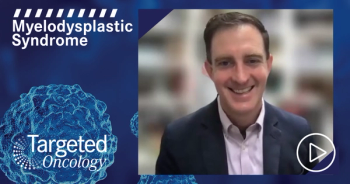
Bexmarilimab With SoC Delivers Promising Results in AML
Bexmarilimab shows encouraging results when combined with standard of care treatments for patients with acute myeloid leukemia and myelodysplastic syndromes.
Bexmarilimab (FP-1305) in combination with standard of care (SoC) shows promise as a potential treatment in patients with relapsed/refractory acute myeloid leukemia (AML) and myelodysplastic syndromes (MDS) who have not responded to hypomethylating agents, according to findings released from the phase 1/2 BEXMAB study (NCT05428969).1
Bexmarilimab binds to immunosuppressive reactor Clever-1, which alters the tumor microenvironment. Twenty-two patients have completed at least 2 treatment cycles, and an estimated 181 total are enrolled in the study. Eight out of 11 patients achieved complete remission in the bone marrow with or without blood count recovery.
"The emerging data from phase 1/2 continue to be extremely promising, showing continued good safety, encouraging efficacy, and long durations of response," said Markku Jalkanen, PhD, chief executive officer of Faron Pharmaceuticals, bexmarilimab’s manufacturer, in a press release. "These results strongly support the planned next step of beginning enrollment of the phase 2 part of the BEXMAB study."
Faron expects to initiate a phase 2 study in late 2023, which will enroll an expected 28-32 patients randomized between 2 doses.
The highest single indication-specific objective response rate (ORR) was observed among patients with MDS (80%). The combined ORR of patients with AML and MDS was 50%, and a 75% blast reduction was observed. A total of 18 treatment-related adverse events (TRAEs) were observed, with a majority below grade 3. Five TRAEs were grade 3 or above.1
The BEXMAB study’s primary end points are incidence and frequency of dose-limiting toxicities, TRAEs, complete response, ORR, complete remission, and minimal residual disease. Secondary end points include progression-free survival, overall survival, anti-bexmarilimab antibody positivity, and serum concentration of bexmarilimab.
Phase 1 of the study is to identify the recommended phase 2 dose. Phase 2 is to investigate the preliminary efficacy of the combination treatment in the selected indications from phase 1.
In phase 1, patients with MDS receive SoC azacitidine as per label and bexmarilimab once a week followed by once every 2 weeks for a 28-day cycle. In phase 1 for patients with AML, SoC azacitidine and venetoclax (Venclexta) was given as per label plus bexmarilimab once a week followed by once every 2 weeks for a 28-day cycle. In phase 2, patients will receive SoC venetoclax and/or azacitidine as per label plus the previously identified dose of bexmarilimab.2
"We believe that bexmarilimab has the potential to provide better patient outcomes and improve the quality-of-life of those suffering from relapsed/refractory AML and MDS, which are conditions with dire prognosis and limited new therapies in the last decades,” Jalkanen added.1










































